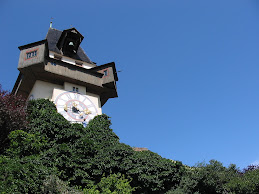- My uniform: I brought ratty farm clothes, knowing they would most likely have no second life after I got back. I found that the best outfit I could wear for any sort of farm work was jeans, a baggy t-shirt, and a baseball cap. Although it got rather hot working outside all day (thankfully minus the humidity of the US East Coast!), jeans were really the best bottom layer because they protected my sensitive city legs from things that bite, sting, burn, or itch…both plant and animal. I also found that a baggy t-shirt was the best top layer—much cooler than anything remotely form-fitting, and I quickly learned that the sleeves offer a useful extra bit of protection as well. Hence the farmer’s tan. I was given a baseball cap and ordered to wear it to protect against the sun; without it, I was warned, I would quickly become tired and develop a headache from working in the sun all day. So I faithfully wore my baseball cap every day, and I was extremely grateful for it!
[my uniform:]
- My schedule: Subject to minor adjustments depending on the day and the harvest, we had breakfast every morning at the slothful hour of 8:30. You may find this surprisingly late for a farm, but since the cows are up grazing on the alpine pasture for the summer, they can afford to get a later start on the main farm. (That being said, the farmer was usually working literally from sunup to sundown.) Lunch (the big, warm meal of the day) was at noon, and then we’d work some more until an afternoon coffee and snack break at about 4 pm. A normal day could end anywhere between 4 pm and 6 pm, giving me an average of 6-8 hours of work per day. Oh, and I worked 6 days a week. And because of the way the hay harvest panned out, I actually only had 2 totally free days the whole time I was there!
- My accommodation: Part of the appeal of WWOOFing is that you provide free manual labor in exchange for room and board. My board was no problem—the mother was used to cooking for a family of 8 anyway—and my room was alternately a converted stable with a bed or the guest apartment, depending on who was staying at the farm. In the stable I had a bed, but I had to go down to the outhouse or the main house if I needed to use the facilities. The guest apartment was a nice treat in comparison, as it even had a TV! I spent about half of my time in each, but I must say that despite its rustic appeal, the dark, damp, spider-ridden stable was the more difficult accommodation; I think it was the allure of knowing that indoor plumbing was available elsewhere that made me feel much more out-of-place in the stable room.
[my farm:]
[my sleeping stable:]
- My farm: I’d unwittingly chosen to go work on the farm of THE herb lady in Tyrol. When I got there I realized that the main attraction on the farm was the herb garden. The farmeress (alas, the English language lacks any distinction between male and female farmers!) gave tours of the herb garden every week, as well as seminars and other such special events, and produced and sold various herbal products. She’s written two books, has been featured national Austrian television, and is considered THE go-to person for herbs in that province. It’s an organic farm, so everything is grown and harvested using the most natural and backbreaking of methods. In addition to the herb garden, there are 8 hectares of land with harvestable hay (on the steep mountainside that constitutes all the farmland), about 30 chickens (and two very chauvinistic roosters), a goat (who honestly thinks it’s a dog), 10 cats (who are expected to earn their keep catching field mice), a couple of guinea pigs (as the daughter’s pets), a couple of rabbits (and the jury’s still out on whether they’re pets or just being fattened up for…well…you know…), a handful of ducks (the tall, skinny kind like in the movie Babe), a couple of bee boxes (which are sadly being invaded by ants), and about 15 cows and calves and 2 sheep currently up in the alpine pastures.
[rooster and goat video:]






2 comments:
Okay, this is absolutely ridiculous, but it still amazes me that the sound a rooster makes actually sounds like its English onomatopoeia. What in the world does a rooster say in German?
Now that that's off my chest, welcome home!! I can't wait to read the next installment of Little Honts on the Prairie. (I know, I know... you were on a mountain, not in a prairie, but I couldn't pass it up.)
And really, I have to apologize that the best I can come up with for the very first comment from me upon your return is "how do you say cockadoodledoo in German. Hopeless. :)
Actually, I am so glad you asked! I think animal noises are funny to compare in different languages, especially in German where both frogs and ducks say "Quag"...but I digress!
In German, the rooster says "Kikeriki"! How quaint!
Post a Comment